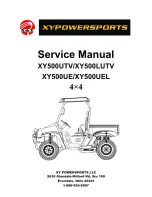
Page K-13
Repair and Service Manual
B
B
MECHANICAL BRAKES
Read all of Section B and this section before attempting any procedure. Pay particular attention to Notices, Cautions, Warnings and Dangers.
7. Check the condition and operation of the moving
anchor assembly (Ref. Fig. 22 on Page K-16).
Operate the brake lever to check for free motion. The
adjuster assembly and brake lever should move
smoothly from front to back on the backing plate. If the
moving anchor assembly is damaged or binds against
the backing plate, replace both of the wheel brake
assemblies.
A backing plate assembly that shows any indi-
cation of galling or gouging is not repairable
and must be replaced with a new wheel brake
assembly. Always replace wheel brake assem-
blies in pairs.
8. Inspect the backing plate.
Inspect for gouges, galling or other damage, particu-
larly where the backing plate is contacted by the brake
shoes and by the moving anchor assembly. Replace
both backing plates if any gouges or galling is found.
9. Measure the brake shoe thickness.
Measure at the most worn area. Brake shoe thickness
must never be less than .06" (1.5 mm) at any point on
the shoe. It is normal for the shoes to show more wear
at the leading and trailing edges (Ref. Fig. 14 on Page
K-12). If the brake shoe thickness is approaching .06"
(1.5 mm), it is recommended that the shoes be
replaced. It is recommended that the brake shoe
springs and brake adjusters be replaced when install-
ing new brake shoes.
10. Inspect the brake shoe springs.
Be sure that they are not broken or damaged and are
correctly installed. The springs must be inserted
with the light spring at the bottom. The long hook is
installed down through the rear brake shoe. The
heavier top spring is installed with the spring hooks
facing up. The heavy top spring is installed with both
spring hooks installed down through the brake shoes
(Ref. Fig. 17 on Page K-13). Repeat procedure at the
opposite wheel brake.
11. Check/adjust brake pedal free travel.
Whenever the brake system is serviced or requires a
parts replacement, the brake pedal free travel must be
checked and adjusted. “Adjusting Brake Pedal Free
Travel” on page 14 This includes all linkage and wheel
brake components.
Fig. 16 Brake Shoe Wear
Fig. 17 Orientation of Brake Shoe Springs
Forward
Forward
A
A
B
B
C
C
D
D
Drum Rotation
Drum Rotation
Driver side
Passenger Side
The pattern of normal brake shoe wear is
shown in quadrant ‘A’, ‘B’, ‘C’ & ‘D’ with
quadrant ‘A’ showing the most wear.
Quadrant ‘B’ will show the second most wear.
Heavy Shoe
Spring
Light
Shoe
Spring
















































